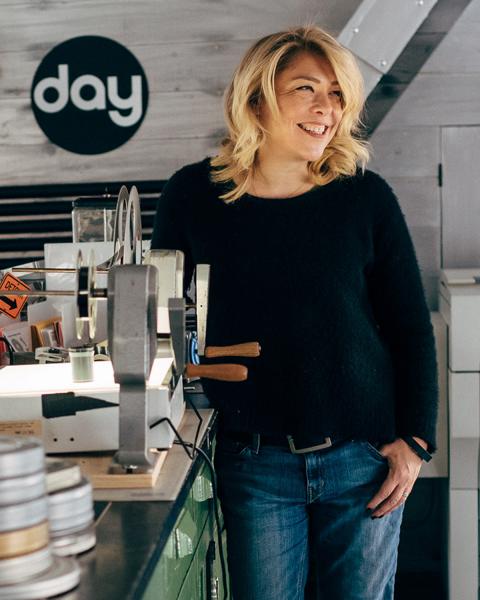Design visionary Bonnie Siegler on perfecting and improving designer-client relations
If there’s one thing we learned from Bonnie Siegler’s amazing new book, Dear Client: This Book Will Teach You How to Get What You Want From Creative People, it’s how important it is for clients to convey their objectives to designers, then get out of their way. As the title suggests, her book is informative, straightforward and chock-full of actionable knowledge and first-hand anecdotes from Siegler’s impressive design career. Voted one of the fifty most influential designers working today, Bonnie’s studio, Eight and a Half, has produced award-winning work for Saturday Night Live, HBO, the Criterion Collection, StoryCorps, and Oprah (an experience she shares in the book). So whether you’re on the client side or part of a creative team, her book is a must-read for minimizing power struggles and encouraging positive communication. We were thrilled to get some additional wisdom from Bonnie, including the importance of being upfront about money and how IRL is pretty much always the best way to present ideas and receive feedback.
“Be open to things you didn’t imagine.”
1.
Creatives often start out positive and full of ideas at the beginning of a project and end with a “let’s get this over with” feeling. What are the top three things clients can do to keep the process painless?
Bonnie Siegler: It’s a complicated process so there are many more than just three, but if I HAD to choose:
1. Tell us about the problems, don’t provide us with solutions. That is our job. When you give us solutions it minimizes the millions of ways we can help and innovate.
2. Be respectful of the work the creatives are doing, even if you don’t like it yet. It’s a process, and it can take time. Work with us, not against us. We are your partner and collaborator.
3. Be open to things you didn’t imagine. This is hard for many people, because as Seth Godin says, it’s difficult to learn something new, because it changes you into someone who disagrees with the person you are. Instead you should think of yourself as a constantly growing and evolving creature who is always interested in new ideas.
2.
What if a client needs a new logo, but doesn’t know exactly what they want? How can creatives make the best use of their time, and help drive the project to success?
BS: The client knows more than they think they do and there are lots of ways to get that information out of them. The creative can begin with discussions about their current identity: what works and what doesn’t. They can move on to the identity of competitors or companies in the same space: again, why they work and why they don’t. Then discuss the hopes and dreams of the client. These three pieces should get both of you on the way to success.
3.
What are some of the best ways to give constructive feedback to creatives?
BS: For presentations I always recommend meeting in person. However, it’s just not realistic to expect every conversation to be in person. So, for constructive feedback, which may come a day or two after the in-person meeting, I recommend a phone call followed up with an email. In a call you can begin by noting that you appreciate the effort, even if the solutions are not working. Or you can explain that even though you have a long list of notes, you are happy with direction. In an email, the long list of notes would trump (excuse the expression) the one sentence of thanks. But in a conversation, it goes a long way to setting up a collaborative, back-and-forth discussion.
If you CAN give feedback during an in-person meeting, that is always ideal. There can be a real back and forth, while looking at the same thing at the same time. Even Skype calls can’t replicate being in the same room. IRL is always best. For everything.
4.
Even though your book is designed to set the client/creative relationship up for success, what are some lessons you’ve learned from failed projects or soured client relationships?
BS: All of the chapters in the book represent things I’ve learned from client relationships. They weren’t all failed or even soured—mostly missed opportunities to make better working relationships by implementing processes that cost no money and take no time.
One example I talk about it in the book was an experience in which a client didn’t want to sign a contract, but preferred a handshake. We insisted on a contract, because it’s the only real way to hope for the best and prepare for the worst. In the end, it turned out this particular client was a liar, and we were ultimately paid ONLY because we had a contract. This chapter is called: “Always Sign on a Dotted Line.”
Another example is the chapter called: “Be Upfront About Money.” Every designer I know has had a conversation with a potential new client who says they have no budget in mind. We then create a proposal only to hear that the number we posed is outside of the budget. This is very frustrating because we may have thought about the job differently, had we known and created a proposal closer to the desired outcome. I guess clients do this because they think we may come in lower than they budgeted. We won’t.
5.
How did you learn how to mentor and work with your teams?
BS: Finding the right designer is a combination of their work, how they speak about the work, and how they communicate on a personal level. Each designer is different and needs a different kind of direction. Knowing that going in makes a big difference. Over time, you learn how to get the best work out of each individual. When to push, when not to push. When to help and when not to help, instead letting them come to the solution on their own.
“Good design meets at the intersection of art and commerce.”
6.
(Reader-submitted question from Kevin Smith, president of 360 Brand Machine) As a longtime ad industry insider, I have seen far more bad clients than good in judging and understanding creatives. This is especially true in the automotive category. But I have also seen creatives that pitch work that is off-strategy or creative for creativity’s sake—that does nothing to address a client’s stated goals. To that point, what can creative types do to become more “trusted advisors” to clients? How do they get that critical trust that allows clients to take a leap of faith and produce bold work that truly makes a difference?
BS: Designers have to be able to communicate WHY their solutions work. If it is just for the sake of a cool solution, they won’t be able to convince anyone. Good design meets at the intersection of art and commerce. For the art to work it has to serve the commerce piece, whether that is selling a car or bringing new audiences to a museum.
A few quickies:
Favorite way to procrastinate?
Instagram. Here are a few favorites:
@hoopsnation: my 17-year-old son’s NBA account (with 619,000 followers)
@jeff_scher: my husband, who is an incredible artist
@lubalincenter: the design god that is Herb Lubalin
@TSA: they post weird stuff that they confiscate
@sammyslabbinck: a Belgian collage artist
@petesouza44: because I still miss Obama so
@abstractsunday: the always-inspiring Christoph Niemann
@andras-szanto: an art curator who documents shows around the world that I don’t get to see
Proudest moment of your design career?
Starting a design firm out of my apartment in 1993.
Lowest moment of your design career?
I can’t think of one, probably because I learned more from those bad experiences than I did from the good ones (and then wrote a book about it)!
Best advice you’ve ever received:
Be nice.
Favorite vacation getaway:
Small Hope Bay in the Bahamas
Designers or artists that inspire you lately or always:
Paul Rand, Cipe Pineles, WIlliam Golden, Andy Warhol
Fun fact: Bonnie’s agency designed the titles for this hit show
Speaking of influential designers...
Some tips for talking about money with clients
Being nice is truly the best advice (plus, it’ll help you sleep)
NEXT UP: SCOTT GALLOWAY





